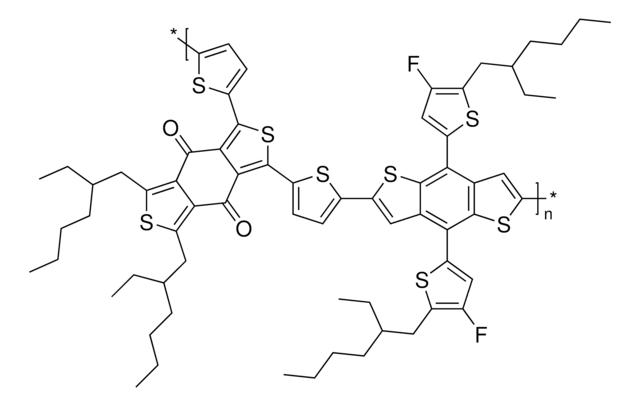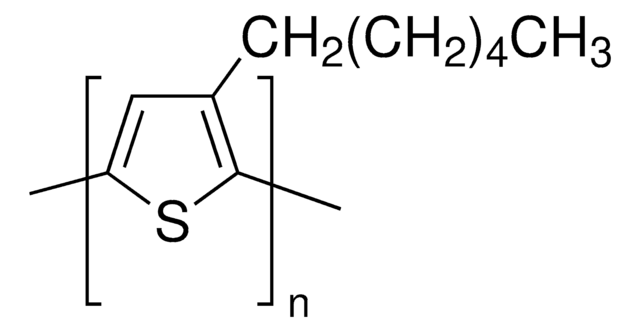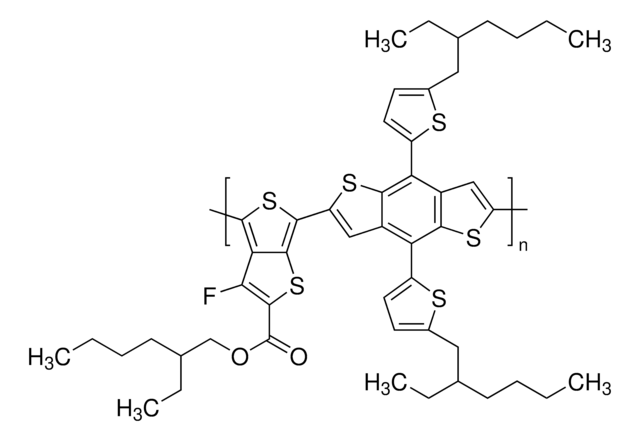684465
[6,6]-Phenyl C71 Buttersäuremethylester, Isomerengemisch
99%
Synonym(e):
3′-Phenyl-3′H-cyclopropa[8,25] [5,6]fulleren-C70-D5h(6)-3′−buttersäure-methylester, 3′H-Cyclopropa[8,25] [5,6]fulleren-C70-D5h(6)-3′−buttersäure, [70]PCBM
About This Item
Empfohlene Produkte
Qualitätsniveau
Assay
99%
Form
powder
Löslichkeit
chlorobenzene: soluble
organic solvents: soluble
toluene: soluble
Energie der Orbitale
HOMO 6 eV
LUMO 3.9 eV
Halbleitereigenschaften
N-type (mobility=0.1 cm2/V·s)
SMILES String
COC(=O)CCCC2(c1ccccc1)C34c5c6ccc7c8cc9Cc%10cc%11cc%12Cc%13cc%14c%15ccc6c3c%15c%16c%17c%18c%19c(c(c57)c8c%20c9c%10c%21c%11c%22c%12c%13c(c%14%16)c%18c%22c%21c%19%20)C24%17
Allgemeine Beschreibung
Anwendung
Lagerklassenschlüssel
11 - Combustible Solids
WGK
WGK 3
Flammpunkt (°F)
Not applicable
Flammpunkt (°C)
Not applicable
Persönliche Schutzausrüstung
dust mask type N95 (US), Eyeshields, Gloves
Hier finden Sie alle aktuellen Versionen:
Besitzen Sie dieses Produkt bereits?
In der Dokumentenbibliothek finden Sie die Dokumentation zu den Produkten, die Sie kürzlich erworben haben.
Kunden haben sich ebenfalls angesehen
Artikel
Since the first publication in 1995 describing a bulk heterojunction photodiode incorporating a methanofullerene, significant progress has been made in improving device performance and the scope of device research has broadened widely.
The field of organic electronics has emerged as the next-generation technology potentially enabling ultra-thin, large-area, and/or flexible devices, consisting of organic field-effect transistors (OFETs), organic light-emitting diodes (OLEDs), and organic photovoltaics (OPVs).
PCBM-based n-type semiconductors - Find p- and n-type organic semiconductors available from Sigma-Aldrich with PCBM library & properties.
The emerging organic photovoltaic (OPV) technology is very promising for low-cost solar energy production. OPV devices can be produced using high-throughput, large-volume printing methods on lightweight and flexible plastic substrates, making them easy to deploy and use in innovative ways.
Unser Team von Wissenschaftlern verfügt über Erfahrung in allen Forschungsbereichen einschließlich Life Science, Materialwissenschaften, chemischer Synthese, Chromatographie, Analytik und vielen mehr..
Setzen Sie sich mit dem technischen Dienst in Verbindung.![[6,6]-Phenyl C61 Buttersäuremethylester ≥99%](/deepweb/assets/sigmaaldrich/product/structures/359/221/d990c746-0960-4c69-bf76-fe09b193824d/640/d990c746-0960-4c69-bf76-fe09b193824d.png)








